
|
Sale 114
The New York Sale
| Lot |
Photo |
Description |
Bidding |
Lot 300 |
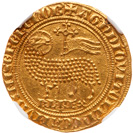 |
Charles IV (1322-1328). Gold Agnel d'or, undated. Lamb and cruciform staff with flying banner. Rev. Floriated cross in quadrilobe (Fr-263). In NGC holder graded MS 63, sharply struck mint state example. Rare. Value $5,000 - UP
Charles IV, the last Capetian King of France, was nicknamed le Bel ("the Handsome") by his contemporaries. Much of his reign was taken up with revolts in Flanders (1323-1326) and conflict with Edward II of England over his French possessions. A crushing victory for Charles IV in the War of Saint-Sardos (1324) allowed him to occupy most of Edward's French lands. Like his father and many of his royal predecessors, in 1326, Charles IV began preparations to embark upon a Crusade largely aimed at capitalizing on the distress of the embattled Byzantine Empire. However, he was prevented from fulfilling his (self-serving) Crusader's vow by his unexpected death in 1328. Dying without a direct male heir created the dangerous situation in which both his nephew Edward III of England and his cousin Philippe of Valois claimed the right to the throne, thereby ushering in the bloody period of the Hundred Years' War (1337-1453).
Ex Terner Collection by Private Treaty.
View details and enlarged photos
|
|
Lot 301 |
 |
Philippe VI de Valois (1328-1350). Gold Lion d'or, undated. King on Gothic throne, holding sceptre and fleur de lis, a lion at feet. Rev. Floriated cross in quadrilobe, crown in angles (Fr 265; Ciani 290). In NGC holder graded MS 63, a splended example of this very rare type. Value $15,000 - UP
Philippe VI, a cousin of the childless Charles VI, succeeded as King of France in 1328 although Charles' closest male relative was his nephew, Edward III of England. Initially the relationship between the two kings was amicable enough, but disputes over Aquitaine finally led the English king to press his claims to the throne of France in 1337. This action precipitated the long and bloody conflict between England and France known as the Hundred Years' War (1337-1454). Faced with a major and expensive conflict, Philippe VI marshalled his finances and issued a wide variety of gold denominations, many of which are represented in this sale. The lion d'or was a gold denomination of 24 carats and 4.895 g introduced by Philippe VI in 1338. The obverse type features an image of the king seated on a Gothic throne-a common type for Philippe IV's gold coins in general. His feet rests on the back of a recumbent lion, the detail which provides the name of the denomination. As the lion has long been an emblem of royalty, it may perhaps appear here to advertise Philippe VI as the legitimate heir to the throne against the claims of Edward III. On the other hand, it may symbolize a hoped-for victory over the English king, since the lion was also the heraldic badge of Edward III and the royal house of Plantagenet.
Ex Terner Collection by Private Treaty.
View details and enlarged photos
|
|
Lot 302 |
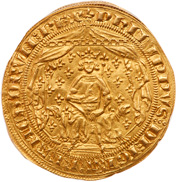 |
Philippe VI de Valois (1328-1350). Gold Pavillon d'or, undated. King holding sceptre, seated on throne under draped pavilion. Rev. Floriated cross in quadrilobe, crown in angles (Fr 266; Ciani 270). In NGC holder graded MS 62, sharply struck and lustrous example, Rare. Value $8,000 - UP
As part of his ongoing development of French gold coinage, in 1339 Philippe VI introduced the pavillon d'or ("gold pavilion") of 24 carats and 5.10 g. Like most of the king's other denominations, the obverse of the pavillon d'or depicts the enthroned figure of the king, but in this case, he is shown seated within an impressive pavilion decorated from top to bottom with fleurs-de-lis-the heraldic emblem of France. This additional feature provides the name of the denomination. The aesthetic quality of the obverse type had an impact on later depictions of Philippe VI. It provided the model for his full-length portrait in Jean du Tillet's Le Recueil des rois de France, an illuminated work on the history of the French monarchy dedicated to Charles IX of France in 1566.
View details and enlarged photos
|
|
Lot 303 |
 |
Philippe VI de Valois (1328-1350). Gold Chaise d'or, undated. King on Gothic throne, holding sceptre and fleur de lis. Rev. Floriated cross in quadrilobe, crown in angles (Fr 269; Ciani 292). In NGC holder graded MS 62, a couple of natural die lines on obverse, fully struck with considerable amount of original mint luster. Value $5,000 - UP
In 1328, Philippe VI began to strike his own version of Philippe IV's chaise d'or-a gold denomination of 24 carats and 7.094 g. The obverse type follows the model of Philippe IV in depicting the king seated on a Gothic throne, but instead of holding a scepter and a fleur-de-lis, now the king carries two scepters. The scepter in his right is the traditional fleur-de-lis scepter of France while the scepter in his left is the Main de Justice ("Hand of Justice") a scepter topped with an ivory Hand of God in a gesture of blessing. This scepter, perhaps used at the coronation of Louis IX (1226-1270) and later refurbished for the coronation of Napoleon I and Charles X still resides in the collection of the Louvre.
Ex Terner Collection by Private Treaty.
View details and enlarged photos
|
|
Lot 304 |
 |
Philippe VI de Valois (1328-1350). Gold Chaise d'or, undated. King with sword and shield, seated on Gothic throne. Rev. Floriated cross in quadrilobe (Fr 270; Ciani 282). In NGC holder graded MS 62, sharply struck with considerable amount of original mint fresh luster. Value $3,000 - UP
View details and enlarged photos
|
|
Lot 305 |
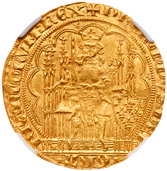 |
Philippe VI de Valois (1328-1350). Gold Ecu d'or, undated. King with sword and shield, seated on Gothic throne. Rev. Floriated cross in quadrilobe (Fr 270; Ciani 282). In NGC holder graded MS 63, sharply struck choice mint state example. Value $2,500 - UP
View details and enlarged photos
|
|
Lot 306 |
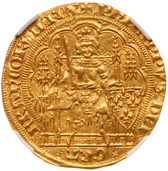 |
Philippe VI de Valois (1328-1350). Gold Ecu d'or, undated. King with sword and shield, seated on Gothic throne. Rev. Floriated cross in quadrilobe (Fr 270; Ciani 282). In NGC holder graded AU 58, sharply struck with a trace of luster. Value $2,000 - UP
The écu d'or ("gold shield") denomination was originally introduced by Louis IX in 1266 to take advantage of the need for denominations larger than the silver denier and to finance his army for the Eighth Crusade (1270). Unfortunately, Louis' écu failed to circulate in France because it was tariffed too low in relation to silver (1 écu = 10 sous tournois) thereby causing the coins to end up in the melter's pot rather than the market place. Following this failure, no further gold écu coinage was produced in France until Philippe VI resurrected the écu as a denomination of 24 carats and 4.53 g valued at 20 sous tournois in 1337. Philippe's new coin was popularly known as the écu d'or à la chaise ("gold shield of the chair") because although it was essentially the same denomination as that of Louis IX, the shield from which it derived its name was replaced by a depiction of the king seated on a throne in the same manner as on Philippe's larger chaise d'or denomination (see lot 314226). The écu d'or à la chaise was distinguished from the chaise d'or by its lighter weight, smaller diameter, and by the shield emblazoned with the arms of France that the king carries. This shield (écu), which is always absent from the chaise d'or serves as a clear denomination indicator for the écu d'or à la chaise.
Ex Terner Collection by Private Treaty.
View details and enlarged photos
|
|
Lot 307 |
 |
Philippe VI de Valois (1328-1350). Gold Couronne d'or, undated (5.43 g). Large royal crown surrounded by fleurs de lis within circle, legend around. +PH'. DI. GRA. REX. FRANC. Rev. Floriated cross in octolobe, crowned fleur de lis in angles. Legend: + XP'C : VINCIT : XP'C : REGNAT : XP'C : IMPERAT: (Fr 275; Dup 252; Ciani 271). In PCGS holder graded MS 64. Finest known. Very Rare. Value $50,000 - UP
Philippe VI introduced the couronne d'or denomination in 1340. It is notable for its departure from the king's earlier coinage that emphasized the image of the king. Here the portrait was replaced by the representation of a crown serving to underline Philippe VI's legitimacy as King of France in the face of the claims of Edward III. The rectangular crown with fleur-de-lis ornaments is the famous Crown of Charlemagne, which had been used first for the coronation of the Frankish King Charles the Bald (843-877). The original jeweled circlet received the addition of fleur-de-lis in the time of Philippe II Augustus (1180-1223) and continued to be used to crown the kings of France until the coronation of Louis XVI in 1775.
View details and enlarged photos
|
|
Lot 308 |
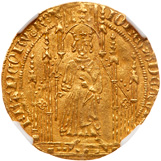 |
Jean II Le Bon (1350-1364). Gold Royal d'or, undated. King with sceptre, standing under Gothic dais. Rev. Floriated cross, fleur de lis in angles (Fr 278; Ciani 358). In NGC holder graded MS 62. Value $2,000 - UP
View details and enlarged photos
|
|
Lot 309 |
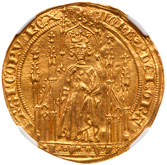 |
Jean II Le Bon (1350-1364). Gold Royal d'or, undated. King with sceptre, standing under Gothic dais. Rev. Floriated cross, fleur de lis in angles (Fr 278; Ciani 358). In NGC holder graded AU 55. Value $2,500 - UP
In August 1358 and April 1359 two emissions of royals d'or ("gold royals") were struck in the name of Jean II although at the time he was being held hostage in Calais by Edward III of England. The royal d'or was originally introduced by Charles IV in 1326 as a gold denomination of 24 carats and 4.219 g. It ceased production in 1326, but was revived in 1358 for the captive Jean II following the recapture of Paris by his son, the future Charles V. However, the two emissions of royals d'or of Jean II were struck to a decreasing weight standard dictated by the financial crisis of the king's defeat and capture. The emission of 1358 weighed 3.708 g while the emission of 1359, to which the present coins both belong, weighed only 2.547 g. The denomination takes its name from the standing royal figure (i.e., the king) who appears on the obverse under a Gothic dais.
View details and enlarged photos
|
|
Lot 310 |
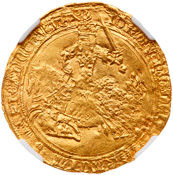 |
Jean II Le Bon (1350-1364). Gold Franc a Cheval, undated (3.77g). Armored King on galloping horse. Rev. Floriated cross in quadrilobe (Fr-279; Ciani 361). In NGC holder graded MS 62, double striking on both sides. Value $2,000 - UP
View details and enlarged photos
|
|
Lot 311 |
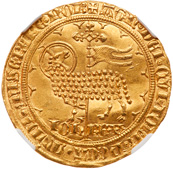 |
Jean II Le Bon (1350-1364). Gold Mouton d'or, undated. Lamb and cruciform staff with flying banner. Rev. Floriated cross in quadrilobe, fleurs de lis in angles (Fr 280; Ciani 354). In NGC holder graded MS 63, sharply struck example with lovely mint bloom. Value $3,500 - UP
Jean II was popularly known as le Bon ("the Good"), but most of his reign was filled with bad. In 1356 he was captured by the Black Prince of Wales at the Battle of Poitiers as part of the ongoing Hundred Years' War (1337-1453) and unemployed mercenary bands plundered the French countryside at will. The Black Death had killed almost half of the population and in 1358 those peasants who had survived rose up in a bloody revolt known as the Jacquerie.
Mouton d'or ("gold sheep") was the nickname given to the gold denomination introduced by Jean II in 1355. The name distinguishes the coin from the typologically identical agnel d'or ("gold lamb") struck by Philippe IV and his sons. Jean II''s mouton enjoyed great popularity and was frequently imitated in the Low Countries. The obverse type depicts the Agnus Dei ("Lamb of God"), a Christian symbol that had often associations with the Crusading movement in France.
View details and enlarged photos
|
|
Lot 312 |
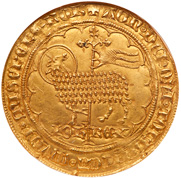 |
Jean II Le Bon (1350-1364). Gold Mouton d'or, undated. Lamb and cruciform staff with flying banner. Rev. Floriated cross in quadrilobe, fleurs de lis in angles (Fr 280; Ciani 354). In NGC holder graded MS 63, another stunning example. Value $3,500 - UP
Ex Terner Collection by Private Treaty.
View details and enlarged photos
|
|
Lot 313 |
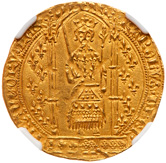 |
Charles V (1364-1380). Gold Franc a Pied, undated. Armored king with sword and sceptre, standing under Gothic dais. Rev. Floriated cross in quadrilobe, fleur de lis in two angles and crown in two angles (Fr 284; Ciani 457). In NGC holder graded MS 63, well struck with attractive mint luster. Value $1,250 - UP
The gold franc denomination was introduced in 1360 in order to meet the crushing terms of the Treaty of Brétigny (May 8, 1360), which required the payment of 3 million crowns to Edward III of England for the return of the captured Jean II. In 1364, Jean's son and successor, Charles V, again struck the franc conforming to the same weight standard (3.885 g) and employing the same type depicting the king charging into battle on horseback. However, in the following year he reduced the weight of the franc to 3.824 g and changed the obverse type to signal this slight weight reduction. Whereas the previous mounted type had been known as the franc à cheval ("on horseback") the new coin was known as the franc à pied ("on foot") because it depicted the armored king dismounted and holding his sword and the Main de Justice ("Hand of Justice") scepter. Although the capture of his father had been a severe blow to French royal power, the type suggested that while Charles V was down, he was not yet out of the Hundred Year's War.
View details and enlarged photos
|
|
Lot 314 |
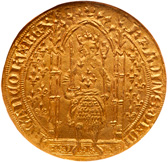 |
Charles V (1364-1380). Gold Franc a Pied, undated. Armored king with sword and sceptre, standing under Gothic dais. Rev. Floriated cross in quadrilobe, fleur de lis in two angles and crown in two angles (Fr 284; Ciani 457). In NGC holder graded MS 62, another attractive mint state example. Value $1,000 - UP
View details and enlarged photos
|
|
Lot 315 |
 |
Charles V (1364-1380). Gold Franc a Pied, undated. Armored king with sword and sceptre, standing under Gothic dais. Rev. Floriated cross in quadrilobe, fleur de lis in two angles and crown in two angles (Fr 284; Ciani 457). In NGC holder graded VF 35. Value $800 - UP
View details and enlarged photos
|
|
Lot 316 |
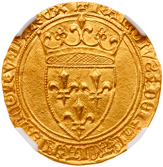 |
Charles VI (1380-1422). Gold Ecu d'or a la couronne, undated (3.73g). Crowned arms of France. Rev. Floriated cross in quadrilobe, crown in angles (Fr 291). In NGC holder graded MS 63, sharply struck on full flan, with attractive mint luster. Value $1,000 - UP
View details and enlarged photos
|
|
Lot 317 |
 |
Charles VI (1380-1422). Gold Mouton or Agnel d'or Emission, undated (2.52g). Lamb and cruciform staff with flying banner. Rev. Floritated cross in quadrilobe, fleur de lis in angles (Fr 290; Ciani 499). In NGC holder graded MS 62. Value $1,250 - UP
View details and enlarged photos
|
|
Lot 318 |
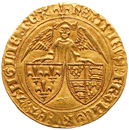 |
Henry VI, King of England and France (1422-1453). Gold Angelot d'or, undated (2.30g). Mint-mark fleur de lis. Saint-Lo mint. Archangel Gabriel over arms of France and England. Rev. Latin cross between fleur de lis and leopard (Fr 300; Dup 444; Elias 22; Spink 8165). In PCGS holder graded AU 58. Very Rare. Value $15,000 - UP
In 1431, the young Henry VI of England was crowned as Henri II of France under the terms of the Treaty of Troyes (1420)-a shameful peace settlement accepted by the reigning French king Charles VI that disinherited his son, the future Charles VII, in favor of the English royal house of Plantagenet. At his coronation, Henry VI became the first and only English monarch to simultaneously wear the crown of England and of France, although subsequent English kings continued to claim rights to the Kingdom of France in speech and heraldry until 1800. Unfortunately for Henry VI, the kinds of crushing victories inflicted by his father on Charles VI began to be meted out on his armies by the resurgent Charles VII while economic and political problems mounted in England. The angelot d'or ("little gold angel") was introduced by Henry VI in 1427, before the turn of the tide in the Hundred Years' War and the loss of English possessions in France. It depicts the Archangel Gabriel behind the arms of France and England and served as a 3/5 fraction of the salut d'or.
View details and enlarged photos
|
|
Lot 319 |
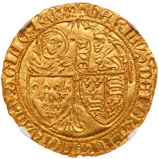 |
Henry VI, King of England and France (1422-1453). Gold Salut d'or, undated (3.46g). Mint-mark fleur de lis. Saint-Lo mint. Madonna and archangel Gabiel behind arms of France and England. Rev. Latin cross between fleur de lis and leopard in polylobe (Fr 301; Elias 271; Spink 8164). In NGC holder graded MS 64, natural flaw near bottom edge, still a lovely fully struck example with abundance of original mint fresh luster. Value $2,000 - UP
The embattled Charles VI introduced the salut d'or ("gold greeting") on August 11, 1421, as a 24 carat gold coin of 3.885 g worth 25 sous tournois. It received its name from the depiction of the Annunciation on the obverse. It was followed almost immediately in November by an emission of saluts d'or struck by Henry V for French territories in his control. His young son, Henry VI (reigning as Henri II of France) produced a second emission in 1423, but this was struck to a lighter standard of 3.496 g. The present salut d'or belongs to this second issue. It differs from Charles VI's original type in several regards-although Gabriel still greets the Virgin Mary with an ave, the positions of the figures are transposed and the arms of both France and England appear as on the angelot d'or fraction. The English lion is also used to punctuate the surrounding legend, leaving no doubt as to the origin of the issuing king.
Ex Terner Collection by Private Treaty.
View details and enlarged photos
|
|
Lot 320 |
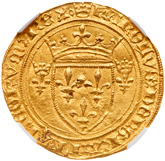 |
Charles VII (1422-1461). Gold Ecu d'or neuf a la couronne, undated. Crowned arms of France flanked by two crowned fleurs de lis. Rev. Floriated cross in quadrilobe, a crown in each angle (Fr 307; Ciani 633). In NGC holder graded MS 63. Value $1,500 - UP
The kingdom of France seemed all but lost to Charles VII, the son of Charles VI. In 1420, his father had disinherited him in order to conclude a shameful peace settlement with the English, and by 1422 much of the French kingdom was in the hands of the English king Henry V, who claimed the title of King of France, or convulsed by a civil war between supporters of the house of Valois and a pro-English Burgundian party. Driven out of Paris, Charles VII was forced to establish his court at Bourges where he considered himself the true King of France, but many derisively referred to him only as "the King of Bourges" since his power did not extend much beyond the walls of the fortified city. This pathetic situation drastically changed in 1429 upon the arrival of Joan of Arc, a peasant girl from Domremy claiming to have had visions from God. She was permitted to lead the French forces against the English who were besieging Orléans and won a spectacular victory. This triumph inspired Charles VII to press the sudden advantage and allowed him to push back the English and have himself crowned at Riems Cathedral in opposition to Henry VI. A new alliance with Philippe the Good of Burgundy in 1435 destroyed any air of legitimacy that Henry VI had as King of France and Charles VII spent the next two decades driving the English out of the kingdom. By the time of Charles' death in 1458, the only remaining English possession was Calais. The long bloodshed of the Hundred Years' War had finally come to an end and France was poised to rise as a great European power.
The present variety of écu is popularly known as an écu d'or neuf à la couronne ("new gold écu with the crown"). It is à la couronne because of the crowns that appear in the angles of the cross on the reverse and neuf ("new") because it reversed a trend of gold debasement for the French écu that had taken place between 1424 and 1429-the nadir of Charles VII's fortunes in the Hundred Years' War. In 1424 the purity of the écu dropped from 24 to 23 carats and continued to fall until 1429 when it was only 18 carats. However, in 1436 the écu d'or neuf was introduced as the English were losing their hold on France and Charles VII felt secure enough to restore the original purity of the gold coinage to 24 carats.
Ex Terner Collection by Private Treaty.
View details and enlarged photos
|
|
Lot 321 |
 |
Charles VII (1422-1461). Gold Ecu d'or neuf a la couronne, undated (3.36g). Crowned arms of France flanked by two crowned fleurs de lis. Rev. Floriated cross in quadrilobe, a crown in each angle (Fr 307; Ciani 633). In NGC holder graded MS 63, another attractive mint state example. Value $1,500 - UP
View details and enlarged photos
|
|
Lot 322 |
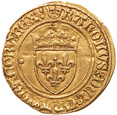 |
Louis XII (1498-1515). Gold Half Ecu d'or au soleil, undated (1.71g). Crowned arms of France, small sun above. Rev. Floriated cross (Fr 324; Ciani 901). In PCGS holder graded AU 53. Scarce denomination. Value $1,750 - UP
The écu d'or au soleil ("gold shield with sun") and its much scarcer half were struck by Louis XII followed a model for the écu that had been established by Louis XI in 1475. The addition of the small sun symbol above the crowned arms of France on the obverse served to indicate that the écu d'or au soleil weighed only 3.496 g and had a gold purity of only 0.963. The denomination enjoyed a great deal of popularity in general and continued to be struck by French kings through the sixteenth and seventeenth century. It is perhaps fitting that the last issues of the écu d'or au soleil were struck by none other than Louis XIV (1643-1715), the Sun King himself.
View details and enlarged photos
|
|
Lot 323 |
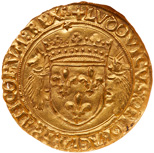 |
Louis XII (1498-1515). Gold Ecu d'or au porc-épic, undated. Crowned arms flanked by two porcupines. Rev. Floriated cross, in two angles an L, in two angles a porcupine (Fr 325; Ciani 909). In NGC holder graded MS 61. Sharply struck with considerable luster. Value $1,500 - UP
The écu d'or au porc-épic ("gold shield with porcupine") was struck by Louis XII in 1507-1508. The porcupine appears to have become a personal badge of the king due to his descent from the House of Valois-Orléans. In 1394, Louis I, the Duke of Orléans instituted the chivalric Ordre du Porc-Épic ("Order of the Porcupine") as a means of increasing the loyalty of his noblemen. However, at the outset of his reign in 1498, Louis XII had actually repressed the order instead preferring to be grand master of the Ordre de Saint-Michel ("Order of Saint Michael") founded by Louis XI. Presumably, over the course of a century the porcupine of the Ordre du Porc-Épic had become so closely connected with the Orléans branch of the royal family that it could remain an emblem of Louis XII even after the dissolution of the order.
View details and enlarged photos
|
|
Lot 324 |
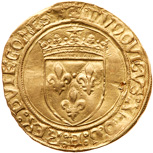 |
Louis XII (1498-1515). Gold Ecu d'or au soleil, de Provence, undated (3.37g). Third type, Aix en provence. Crowned arms, small radiate sun above. Rev. Floriated cross (Fr 332b; Dup 653a). In NGC holder graded AU 50. Value $2,000 - UP
View details and enlarged photos
|
|
Lot 325 |
 |
Louis XII (1498-1515). Gold Ecu d'or au soleil, undated (3.39g). Crowned arms of France with small sun above. Rev. Floriated cross (Fr 323; Dup 647). In PCGS holder graded AU 58. Value $600 - UP
View details and enlarged photos
|
|
Lot 326 |
 |
Francois I (1515-1547). Gold Ecu d'or, undated. Crowned arms, small radiate sun above. Rev. Two F's and two lis in angles of cross (Fr-345; Ciani 1073 var). In NGC holder graded MS 62, struck on full flan with luster. Value $1,000 - UP
The French king François I earned his popular nickname le Roi-Chevalier ("the Knight-King") through his tendency to charge impetuously into battle at the head of his knights, particularly when fighting against the forces of his arch-nemesis, the Habsburg Charles V. The knightly leadership of the French king was especially visible during several outbreaks of the continuing Italian Wars (1494-1559), such as the War of the League of Cambrai (1508-1516), the Four Years' War (1521-1526), and the War of the League of Cognac (1526-1530), but it sometimes got him into trouble. Following an ill-timed charge at the Battle of Pavia (1525), late in the Four Years' War, François I found himself captured and held hostage in Madrid until he was ransomed. Nevertheless, at the same time that François I continued to embrace the medieval ideal of the warrior king, his policies in France looked to the future and began the process of centralization that would ultimately result in royal absolutism. In 1593, the Ordinance of Villers-Cotterêt replaced Latin with French as the administrative language of the kingdom in favor of French, ordered the registration and authentication of births and deaths by ecclesiastical and public notaries, and prohibited guilds. The king also became a great patron of the arts, luring Italian masters like Leonardo da Vinci to France and creating the conditions for a French Renaissance.
View details and enlarged photos
|
|
Lot 327 |
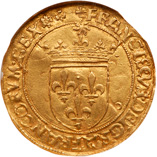 |
Francois I (1515-1547). Gold Ecu d'or, undated. Crowned arms, small radiate sun above. Rev. Two F's and two lis in angles of cross (Fr 345; Ciani 1073 var). In NGC holder graded AU 50. Value $700 - UP
View details and enlarged photos
|
|
Lot 328 |
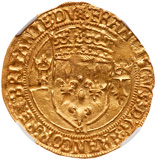 |
Francois I (1515-1547). Gold Ecu d'or de Bretagne, undated. Nantes mint. Crowned arms flanked by an F and an ermine. Rev. Two F's and two ermines in angles of cross (Fr 364; Ciani 1088). In NGC holder graded MS 62, with brilliant mint luster. Value $1,500 - UP
The custom of including the crowned initial of the reigning king within or flanking the reverse cross design of the French gold écu goes back to the reign of François I's predecessor, Louis XII (1498-1515). However, under François I the royal initial also began to appear on the obverse as well, as on these écus from the respective mints of Rennes and Nantes. Due to the mint locations in the Duchy of Brittany, such écu varieties are generally known as écus d'or de Bretagne. The crowned ermine that also appears in conjunction with the crowned initial of François I on écus d'or de Bretagne serves not only as a symbol of kingship (the French royal coronation mantle was trimmed with ermine fur) but also to signal the origin of the coins in Brittany and to advertise its connection to France. Since the 1380s the primary seat of the semi-independent Dukes of Brittany was the Château de l'Hermine (Ermine Castle). In 1532, François I stayed at this castle during a vote by the estates of Brittany that began the process of fully annexing the duchy to the Kingdom of France. Ironically, once Brittany had become united with France Château de l'Hermine lost its purpose and soon fell into disrepair. Brittany had also previously played a crucial role in François' succession to Louis XII. When the latter fell ill in 1505, he feared disaster for France upon his death since he was childless. In order to guarantee a smooth succession and preserve the kingdom from potential civil war, Louis XII immediately commanded his cousin François to be betrothed to Claude, his daughter by Anne of Brittany. The two were married in 1514, at which time François I became Duke of Brittany jure uxoris and in the following year became King of France.
View details and enlarged photos
|
|
Lot 329 |
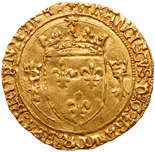 |
Francois I (1515-1547). Gold Ecu d'or de Bretagne, undated (3.41g). Second type. Rennes mint. Crowned arms flanked by two minks. Rev. Two F's and two ermines in angles of cross (Fr 363; Dup 790; Ciani 1087). In PCGS holder graded AU 50. Value $750 - UP
View details and enlarged photos
|
|
Lot 330 |
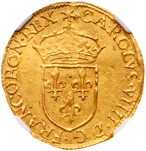 |
Charles IX (1560-1574). Gold Ecu d'or, 1567-B (3.29g). Rouen mint. Crowned arms. Rev. Floriated cross with mint mark in center (Fr 378; Ciani 1344). In NGC holder graded MS 63. Value $1,000 - UP
View details and enlarged photos
|
|
Lot 331 |
 |
Henry III (1574-1589). Gold Ecu d'or au soleil, 1578-K (3.3g). Bordeaux mint. Crowned arms of France. Rev. Lobed floriated cross (Fr 386; Dup 1121A). In PCGS holder graded AU Details (Cleaned). Value $1,000 - UP
Although he initially reigned as the elected King of Poland-Lithuania (1573-1575), Henri III returned to France in 1574 to succeed his brother Charles IX as King of France. His reign was troubled by the continuing French Wars of Religion (1562-1598) in which Catholic and Protestant foreign powers stoked civil war between religious factions within France. Spain and the Papal States (together part of a Catholic League) supported the Catholic faction against the Huguenot party backed by English and Dutch Protestants. Meanwhile, a third front in the conflict was opened by the Malcontents, a combined Catholic and Protestant party dedicating to curbing the king's increasing absolutist tendencies. A major war broke out in 1587 over the possibility that the Protestant Henri of Navarre would succeed the childless Henri III as King of France. This became known as the War of the Three Henris (1587-1588) because it not only involved Henri III and Henri of Navarre, but also Henri of Guise, the leader of the Catholic League forces who used his military successes to drive Henri III out of Paris. The number of Henris spoiling France was gradually reduced as the conflict dragged on. Henri of Guise was murdered by royal agents in 1588 and in the following year Henri III was himself assassinated. This left only Henri of Navarre still standing and ready to succeed as king-the very prospect that had ignited the war in the first place!
View details and enlarged photos
|
|
Lot 332 |
 |
Louis XIII (1610-1643). Gold Half Ecu d'or, 1625-A (1.68g). Paris mint. Hammered coinage. Crowned arms of France. Rev. Lobed floriated cross (Fr 399; Gad 53; KM 40.1). In PCGS holder graded AU 55. Value $3,000 - UP
View details and enlarged photos
|
|
Lot 333 |
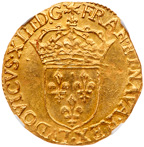 |
Louis XIII (1610-1643). Gold Ecu d'or, 1636-B (3.29g). Rouen mint. Hammered coinage. Crowned arms of France. Rev. Lobed floriated cross (Fr 398; Gad 55; KM 41 type). In NGC holder graded MS 62, brillaint mint luster. Value $1,500 - UP
View details and enlarged photos
|
|
Lot 334 |
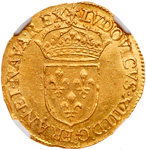 |
Louis XIII (1610-1643). Gold Ecu d'or, 1636-A (3.36g). Paris mint. Hammered coinage. Crowned arms of France. Rev. Lobed floriated cross (Fr 398; Gad 55; KM 41.1). In NGC holder graded MS 60, lustrous mint brilliance visible. Value $1,250 - UP
View details and enlarged photos
|
|
Lot 335 |
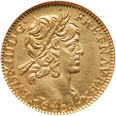 |
Louis XIII (1610-1643). Gold Half Louis d'or, 1640-A (Paris). Laureate bust right. Rev. Crowned double L's in cross form, fleur-de-lis in angles and mint mark in center (Fr 411; Gadoury 57; KM 101). In NGC holder graded MS 61, lustrous. Value $1,500 - UP
Much more innovative was the introduction of the louis d'or ("gold Louis") denomination and its half by Louis XIII on March 31, 1640. The louis d'or sought to emulate the popular Spanish gold two-escudo piece, known in France as the pistole, in its weight and fineness (22 carats, 6.75 g) and featured a portrait of Louis XIII on the obverse and a cross formed from a double L monogram of the king's initial. The use of a royal portrait was new for French coinage-previous monarchs had tended to use their crowned initial instead-and served to explicitly advertise the person of the king as the source of the coinage. The introduction of the portrait and the absolutism of Louis XIII go together hand and hand. It is also notable that whereas the earlier coinage of Louis XIII was hammered, the new louis d'or and its half were milled and struck using a screw press. In every way they express the entry of France into a new age.
View details and enlarged photos
|
|
Lot 336 |
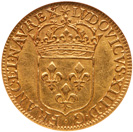 |
Louis XIII (1610-1643). Gold Ecu d'or, 1642-A, Paris. Hammered coinage. Crowned arms of France. Rev. Lobed floriated cross (Fr 398; Gadoury 55; KM 41.1). In NGC holder graded AU 58, much original luster remaining. Value $900 - UP
Following the assassination of Henry IV in 1610, his 10-year-old son was crowned King of France as Louis XIII. Too young to reign in his own right, the government was placed in the hands of his mother and mismanaged by her Italian favorites. At last, in 1617, Louis XIII came of age and took power into his own hands, exiling his mother and executing her associates. With the assistance of advisors like Charles d'Albert and especially Cardinal Richelieu, the young king concentrated power in the crown at the expense of the French nobility and became the first true absolute monarch in Europe. As part of this centralizing process, Louis XIII abandoned his father's previous conciliatory policies towards the Protestant Huguenots, and actively developed the education system in France by founding the Académie française. Despite the changes in the character of the French monarchy under Louis XIII, his coinage was rather conservative. The écu d'or ("gold shield") and its half continued to feature the usual types of his predecessors, a crowned shield bearing the fleurs-de-lis arms of France on the obverse and a floriate cross on the reverse.
View details and enlarged photos
|
|
Lot 337 |
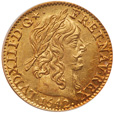 |
Louis XIII (1610-1643). Gold Half Louis d'or, 1642-A (Paris). Laureate bust right, with long curl. LVD. XIII. D.G star. Rev. Crowned double L's in cross form, fleur-de-lis in angles and mint mark in center (Fr 411; Gadoury 57; KM 125). In PCGS holder graded MS 63, sharply struck with original mint fresh luster and peripheral toning. Value $2,000 - UP
View details and enlarged photos
|
|
Lot 338 |
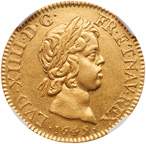 |
Louis XIV (1643-1715). Gold Louis d'or a la meche courte, 1645-D (Lyon). Laureate child bust with short curl. Rev. Crowned double L's in cross form, fleur-de-lis in angles and mint mark in center (Fr 415; Gadoury 244; KM 149.2). In NGC holder graded AU 50, with pleasing mint luster. Value $2,500 - UP
View details and enlarged photos
|
|
Lot 339 |
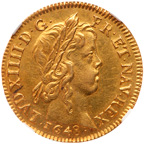 |
Louis XIV (1643-1715). Gold Louis d'or a la meche longue, 1648-& (Aix). Laureate child bust with long curl. Rev. Crowned double L's in cross form, fleur-de-lis in angles and mint mark in center (Fr 418; Gadoury 245; KM 157.22). In NGC holder graded AU 58, with pleasing mint luster. Value $3,000 - UP
View details and enlarged photos
|
|
Lot 340 |
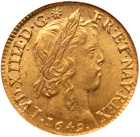 |
Louis XIV (1643-1715). Gold Louis d'or a la meche longue, 1649-A (Paris). Laureate child bust with long curl. Rev. Crowned double L's in cross form, fleur-de-lis in angles and mint mark in center (Fr 418; Gadoury 245; KM 157.1). In NGC holder graded MS 64, lovely original mint brilliance. Value $3,000 - UP
View details and enlarged photos
|
|
Lot 341 |
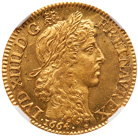 |
Louis XIV (1643-1715). Gold Louis d'or au buste juvenile, tete lauree, 1664-A (Paris). Laureate bust of youthful king right. Rev. Crowned double L's in cross form, fleur-de-lis in angles and mint mark in center (Fr 421; Gadoury 246; KM 200.1). In NGC holder graded MS 66, a sparkling gem. Value $3,500 - UP
View details and enlarged photos
|
|
Lot 342 |
 |
Louis XIV (1643-1715). Gold 2 Louis d'or a l'ecu, 1690-B (Rouen). Older laureate bust of king with long hair right. Rev. Crowned arms of France (Fr 428; Gadoury 259; KM 280.2). In NGC holder graded AU 55. evenly struck example with hints of underlying luster. Rare. Value $6,500 - UP
View details and enlarged photos
|
|
Lot 343 |
 |
Louis XIV (1643-1715). Gold Half Louis d'or a l'ecu, 1690-A (Paris). Older lauereate bust of king with long hair right. Rev. Crowned arms of France (Fr 430; Gadoury 239; KM 277.1). In NGC holder graded AU 58, evenly struck with underlying mint luster. Value $2,500 - UP
View details and enlarged photos
|
|
Lot 344 |
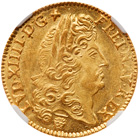 |
Louis XIV (1643-1715). Gold Louis d'or a l'ecu, 1691-N (Montpellier). Older lauereate bust of king with long hair right. Rev. Crowned arms of France (Fr 429; Gadoury 250; KM-278.11). In NGC holder graded MS 64, a choice fully lustrous mint state example. Value $3,000 - UP
Between 1690 and 1693 a variety of the louis d'or with its double and half was struck replacing the more usual reverse type featuring designs composed of the royal monogram with a crowned shield emblazoned with the fleur-de-lis arms of France. This variety was popularly known as the louis d'or à l'écu ("gold Louis with the shield") for fairly obvious reasons. The rather more national than personal tone of this reverse type came at a time when the generals of Louis XIV had been winning a string of battles against the combined forces of the Holy Roman Empire, Spain, the Dutch Republic, England, and Savoy in the War of the League of Augsburg (1688-1697).
Ex Terner Collection by Private Treaty.
View details and enlarged photos
|
|
Lot 345 |
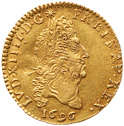 |
Louis XIV (1643-1715). Gold Half Louis d'or aux 4 L, 1696-A (3.37g). Paris mint. Old laureate head with long hair right. Rev. Four cruciform L's and four crowned fleurs de lis (Fr 434; Gad 240; KM 301.1). Reformation period with signs of over striking on earlier type. In PCGS holder graded AU 53. Value $700 - UP
The half louis d'or aux quatre L ("gold Louis of four Ls") was introduced by Louis XIV alongside the full and double louis d'or in 1693 and was struck until 1700. It is notable in that the reverse cross design in composed of only four initials (L) of the king's name rather than eight (with two Ls back to back forming the arms of the cross) as on the louis d'or aux huite L ("gold Louis of eight Ls"). The latter seems to have been a more popular design since the louis d'or aux quatre L was produced over a relatively short period whereas the louis d'or aux huite L was struck in 1643-1648, 1651-1690, 1700-1704 and 1709-1715. It was even revived in 1715-1716 during the regency for Louis XV.
View details and enlarged photos
|
|
Lot 346 |
 |
Louis XIV (1643-1715). Gold Louis d'or aux 8 L et aux insignes, 1701-S (Reims). Old laureate head with short hair right. Reverse; Four cruciform crowned double L's over crossed insignia (Fr 436; Gad 253; KM 334.18). In NGC holder graded MS 62, reformation period with signs of overstriking from earlier type. Original mint brilliance beneath lovely light tone. Value $1,500 - UP
View details and enlarged photos
|
|
Lot 347 |
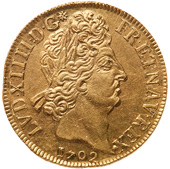 |
Louis XIV (1643-1715). Gold 2 Louis d'or aux 8 L et aux insignes, 1702-A (Paris). Older laureate head of king with shorter hair right. Rev. Four cruciform crowned double L's over crossed insignia (Fr 435; Gadoury 261; KM 335.1). In NGC holder graded AU 58, a very pleasing example with nearly full original mint luster remaining. Value $5,000 - UP
The louis d'or aux ensignes ("gold Louis with royal insignia") was introduced on June 19, 1700 and continued to be struck through 1709. It is notable in that the standard reverse type depicting a cross formed by the repeated crowned initial of the royal name has now had crossed royal scepters added to the design. A scepter tipped with a fleur-de-lis and another tipped with the hand of God in a benediction gesture both played roles in the coronation ritual of the French monarchy. The latter scepter was known as the Main de Justice ("Hand of Justice") and is thought to have been first used for the coronation of Louis IX (St. Louis). The addition of these symbols of royal legitimacy came at a time when Louis XVI was preparing for the War of the Spanish Succession (1701-1714).
View details and enlarged photos
|
|
Lot 348 |
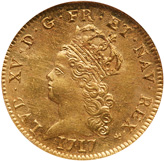 |
Louis XV (1715-1774). Gold 2 Louis d'or de Noailles, 1717-A (Paris). Crowned child bust left. Rev. Cross of four shields with arms of France and Navarre, lis in angles (Fr 450; Gadoury 344; KM 428.1). In NGC holder graded MS 62, striation marks on obverse, full original mint brilliance. Popular design type. Value $3,000 - UP
The louis d'or de Noailles ("gold Louis of Noailles") is named after Adrien-Maurice, Duke of Noailles, who served as president of the Royal Council of Finances during the regency for Louis XV between 1715 and 1718. This louis d'or variety was struck under the features a very young portrait of the monarch wearing his coronation crown. Although most of the royal crowns were stolen and destroyed during the excesses of the French Revolution (1789-1799), the crown depicted on this coin variety still survives in the collection of the Louvre Museum. The reverse type forms a cross from shields bearing the heraldic blazons of France and Navarre.
View details and enlarged photos
|
|
Lot 349 |
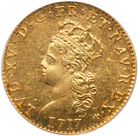 |
Louis XV (1715-1774). Gold Louis d'or de Noailles, 1717-A (Paris). Crowned child bust left. Rev. Cross of four shields with arms of France and Navarre, lis in angles (Fr 451; Gadoury 335; KM 430.1). In PCGS holder graded MS 63, well struck with full original mint brilliance of this popular design type. Value $3,500 - UP
View details and enlarged photos
|
|
|
|